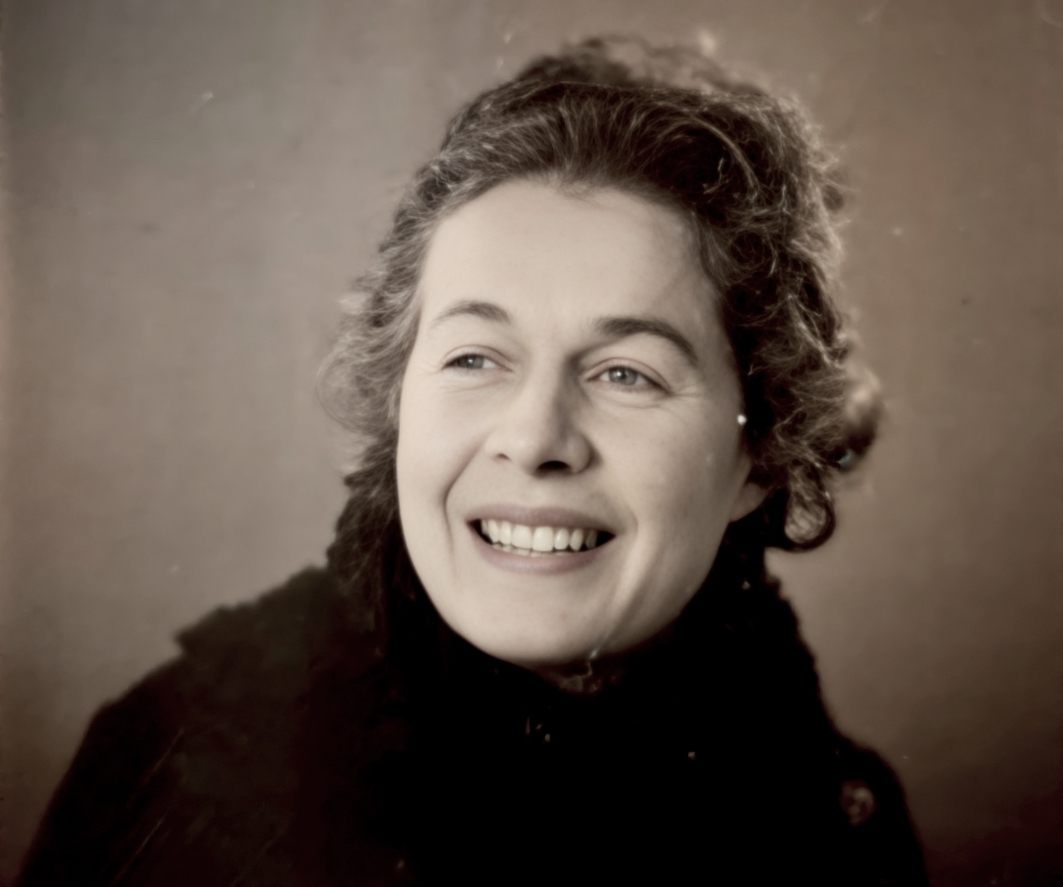The Swedish Female Adventurer Who Sailed Solo Around the World
From dodging bullets in the Black Sea to hiding from police in Tibet, Aina Cederblom lived life on her terms.
It was the spring of 1938, and a woman sailing on the Bay of Bengal was dreaming of snow. Maybe it was the burn blisters on her skin or the escape from the Indian Imperial Police that had made the adventurer Aina Cederblom sentimental. After two and a half years of sailing solo through Asia, she was ready to head home to Sweden—at least that was the 39-year-old’s plan. Fate had other ideas.
During the early 20th century, Aina Cederblom kept popping up in unexpected corners of the world, from Greenland to India to the Philippines. By the 1930s, Cederblom and her solo sailing adventures were well-known throughout Europe. Newspapers reported about how she went missing in Greenland’s glacier-filled waters, hid from the police in Tibet, and was shot at in the Black Sea. Yet, the memory of her norm-breaking achievements has almost disappeared today. That is, until her grandnephew, two museum curators, and a new generation of Swedes began to retell Cederblom’s daring story.
Born on September 26, 1896, in Stockholm, Sweden, Cederblom was brought up in a wealthy Swedish family. She graduated from Konstfack, Stockholm’s famed University of Arts, Crafts and Design. After her studies, she worked briefly as a primary school drawing teacher but found the school system too repressive and began teaching weaving classes on her own—forging a career at a time when many women were barred from doing so.
As Cederblom came of age, Sweden was going through a massive, social upheaval. Swedish women gained the right to vote in 1921—the same year Cederblom turned 25. Even with the vote, Swedish women struggled for equality. When Cederblom went on her first solo sailing trip around Europe in 1931, Swedish women were not even allowed to legally work as sailors.
“In general, it was expected that women should stay ashore, unless they were passengers,” says Ninna Boberg, who organizes educational events at the Gothenburg Maritim Museum. Together with Karl Hellervik, a program curator at the museum, Boberg facilitates the recurring lecture series Women at Sea featuring Cederblom.

Despite laws barring women from being sailors, at 34 Cederblom bought her first boat, a 13-foot open boat with an outboard motor and oars made of Swedish pine, and sailed off into Europe’s rivers and seas. She had no sailing experience, no marine charts, and a fur coat instead of a sleeping bag. Soon, Cederblom’s European adventure skyrocketed her to fame in the Swedish press.
Cederblom was far from the only woman traveling by ship at the beginning of the 20th century. European aristocratic white women were frequent passengers on luxurious cruise lines. They were often widows with inherited money, traveling without male companionship. Meanwhile, women who came from more meager means worked in terrible conditions onboard, often in the ship’s kitchens.
But it was how Cederblom traveled that set her apart. In Boberg and Hellerviks’ research, they found that Cederblom captained her own boat, and sometimes even took control of others’ ships. In one story, Cederblom boarded a stranger’s ship and—without permission—began commanding his crew.
“She was Pippi Longstocking before Pippi Longstocking existed,” says Boberg. “She was crazy! She could have perished half of the times—but she didn’t,” says Hellervik. Cederblom’s daring, norm-breaking personality is why the museum curators have chosen to highlight her adventures. “We think it’s important to highlight people who go against the grain, who don’t always do what is considered appropriate, but follow their own head,” says Hellervik.

Henrik Cederblom, Aina Cederblom’s grandnephew, remembers her as someone who didn’t follow societal conventions. “She had no interest in establishing herself in a system someone else had decided. There was probably no place for someone like her in the upper-class environment she came from, and it was probably something she needed to solve—and did [so] in her own way,” he says.
Growing up, Cederblom was surrounded by progressive women. Her aunt Elin Cederblom was a sexologist and her second aunt Gerda Cederblom was an ethnologist and author: Both were members of the pioneering Swedish women’s association Sällskapet Nya Idun. Cederblom’s unusual access to strong female and male role models (her father, Harald Cederblom, was a major in the Swedish military) may explain her unabashed free spirit and disregard for rules.
In 1931, during her first European sailing trip, rumors circulated that bandits had attacked Cederblom. Her family telegraphed every Swedish consulate in the Mediterranean, demanding her to come home—an order Cederblom ignored.
In 1933, during her second adventure in Greenland, she and her boat got a lift with a ship from the Faroe Islands. When the captain refused to let her go ashore to Greenland, she convinced a sailor to wake her up in the night and cut her hair off, so she could pretend to be a man and be smuggled ashore.
In June 1938, people must have dropped their jaws when they read the first page of Cederblom’s travelog Nocturnal escape through the jungle, which was published in the Swedish magazine Vecko-Journalen. At the time, Cederblom was in Asia on her third solo sailing trip. After a year of teaching weaving at the poet and Nobel Prize winner Rabindranath Tagore’s school in West Bengal, India, she was attempted to cross the strictly guarded Sikkim border into Tibet. In the story for Vecko-Journalen, she recounts how she was unjustly arrested at the border and had to take matters into her own hands: “I just jumped out of the [prison] window and ran away. Inside the cabin, my two prison guards were thinking I was having my bath.”

In following articles for Vecko-Journalen, Cederblom shared with readers how fat leeches crawled along her bloody ankles close to the Sikkim border. She wrote about how she slept in chicken houses, accidentally ate poisonous herbs, and tiptoed barefoot past sleeping guards. But after crossing the border into Tibet, she went silent.
Growing up, Henrik Cederblom was used to his grandaunt’s mysterious ways. “We don’t know exactly how she solved all the problems she encountered,” he says, remembering how Cederblom would tell colorful stories of her adventures from his parents’ sofa. He thought of her like Tintin, the adventurous Belgian cartoon character. Just like Tintin, Cederblom had a miraculous way of getting out of tricky situations unscathed.
Cederblom’s signature boldness was exactly what Henrik Cederblom and his wife Lotta Sjölin Cederblom, both musicians and actors, hoped to capture in their children’s musical theater show, Aina—the Adventure of a Sea-Vagrant. The play, directed by Gunilla Johansson Gyllenspetzare, premiered in 2021 and is part of a recent revival of Cederblom in the public eye, especially in Sweden.
Hellervik believes the renewed interest in Cederblom’s story stems from many Swedes searching for a more nuanced version of history: “To show that the previous view of men’s and women’s roles in history have been greatly simplified and that [the] reality has always been more multifaceted.”

Cederblom’s adventures took place in a ground-breaking era of travel. European colonialism and missionary movements made travel far more accessible for wealthy, upper-class, white Europeans, especially in the 18th century and beyond. Improved camera techniques also made the personal travelogue format easier, says Hellervik, and wealthy, upper-class women often had increased publishing access for their books and articles.
“Adventurous women have probably always existed, but it was during this time that [certain] women were given more room to be individuals,” says Boberg. Freya Stark, Gertrude Bell, Juanita Harrison, Eva Dickson (also from Sweden), Ella Maillart, and Alexandra David-Néel are just a few examples of intrepid female travel writers active at the same time as Cederblom.
By the end of 1939—a year and a half after Cederblom had “decided” to head home from India, but instead spent months traversing Asia’s rivers and seas—World War II forced Cederblom back to Europe. For the next decade, she initiated large-scale humanitarian aid efforts. During the aftermath of the Winter War between Finland and the Soviet Union, she used her boat to transport building supplies for refugee housing in the Finnish archipelago and helped organize and supply food kitchens in Helsinki.
Throughout the 1950s and 1960s, not much is known about Cederblom’s whereabouts, except that she lived in the United States, and later in Brazil. In the northeast coastal city of Olinda, Brazil, Cederblom opened two weaving schools. The schools, including a third one in Klaksvik in the Faroe Islands, would become an important part of her legacy—offering, especially women, a tool for an independent income.

Following her adventures, a Swedish publisher persuaded Cederblom to write about her solo adventures, first in On a Spin Through Europe (“På snurrefärd genom Europa”) in 1932 and then in A Vagabond on the Atlantic (“Som sjöluffare på Atlanten”) in 1934. But it wasn’t until 1979, that someone else would write a book about her: William Rigmark’s humble Vagabond of the Oceans (“Världshavens Vagabond”). A year later, in 1980, at the age of 84, Cederblom was interviewed on Swedish national television for the show This is Your Life. The program made shockwaves and Cederblom again rose to national stardom before she died in 1986. Over the next few decades, her fame would again fade from Swedish memory.
Then, in 2017, the Swedish book An Other Story (“En annan historia”) with portraits of forgotten historical women was published. Even though Cederblom wasn’t part of the portraits, the book’s editor, Lina Thomsgård, dedicated the foreword to Cederblom, crediting her as the main inspiration for the book. Thomsgård had only heard of Cederblom a few years prior. “How could the world have kept this woman away from me?” she complained. “Why were there four—soon to be five—excessive featured films about a fictional Indiana Jones but none about a real Aina Cederblom?” It’s an error that curators Boberg and Hellervik and Cederblom’s grandnephew have been helping to change.
Cederblom herself never seemed interested in her legacy or being remembered. Under the headline “Swedish Girl’s Lone Voyage” in a 1935 edition of The Singapore Free Press, Cederblom made that crystal clear: “Now, please, don’t think I am what the storybooks would describe as an adventure-loving intrepid woman. Far from that!” After all, it comes as no surprise, that Cederblom would rail against any kind of label—even the label of adventurer.
















Follow us on Twitter to get the latest on the world's hidden wonders.
Like us on Facebook to get the latest on the world's hidden wonders.
Follow us on Twitter Like us on Facebook